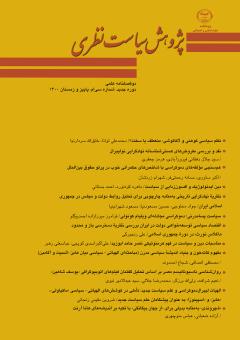نظریۀ نهادگرایی تاریخی بهمثابه چارچوبی برای تحلیل روابط دولت و مجلس در جمهوری اسلامی ایران
محورهای موضوعی : Research in Theoritical Politicsجواد محلوجی 1 , حسین مسعودنیا 2 , مسعود شهرام نیا 3
1 - دانش آموخته دکتری علوم سیاسی، دانشگاه اصفهان
2 - دانشیار گروه علوم سیاسی، دانشگاه اصفهان
3 - دانشیار گروه علوم سیاسی، دانشگاه اصفهان
کلید واژه: نهادگرایی, نهادگرایی جدید, نهادگرایی تاریخی, دولت و مجلس. ,
چکیده مقاله :
فهم و تحلیل روابط دولت و مجلس در جمهوری اسلامی ایران در سال های اخیر در کانون توجه سیاست مداران، روزنامه نگاران و محققان قرارگرفته است. از آنجا که واقعیت ها خود سخن نمی گویند و نیاز به تفسیر و سازمان دهی دارند، مقاله بر آن است تا تکیه گاهی نظری برای این منظور فراهم آورد. نقطه عزیمت بحث، نظریۀ نهادگرایی تاریخی و تنقیح جایگاه آن در میان نظریه های مختلف در حوزۀ علوم سیاسی است. پس پرسش این است که نهادگرایی تاریخی چه فرصت و یا بصیرتی را برای جمعآوری داده ها و چه ابزاری برای تحلیل آنها در اختیار پژوهشگران این حوزه قرار می دهد؟ پس از آنکه امکان های روشی موجود در نظریۀ نهادگرایی تاریخی برای تحلیل روابط دولت و مجلس استخراج شد، در قسمت دوم، مقاله می کوشد نقشۀ راهنمایی برای جمع آوری و تحلیل داده ها در موضوع روابط دولت و مجلس در سال های پس از بازنگری در قانون اساسی ارائه نماید.
Understanding and analyzing the relationship between government and parliament in the Islamic Republic of Iran has been the focus of politicians, journalists, and researchers in recent years. Since facts do not speak for themselves and need to be interpreted and organized, the article seeks to provide a theoretical basis for this purpose. The starting point of the discussion is the theory of historical institutionalism and the refinement of its position among various theories in the field of political science. The question, then, is what opportunities or insights does historical institutionalism provide for researchers in this field, and what tools for analyzing them? After extracting the methodic possibilities in the theory of historical institutionalism for analyzing the relationship between government and parliament, in the second part, the article tries to provide a guide map for collecting and analyzing data on the relationship between government and parliament in the years after reviewing the constitution.
